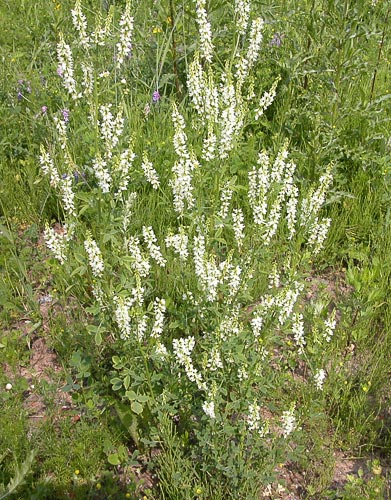Crops
Melilotus albus Medic. - White sweetclover, white melilot, Bokhara clover.
Taxonomic position.
Family Leguminosae Endl., genus Melilotus Mill.Morphology and biology.
Chromosome number: 2n=2x=16. Erect or ascending biennial or annual, up to 1.5 m, with trifoliate leaves. Leaflets obovate, dentate in upper third and with terminal leaflet on longer petiole than lateral leaflets. Single well-branched stem in establishment year but in following year several stems originate from crown buds. The succulent stems become fibrous with age. Deeply tap-rooted. Considerable root enlargement, together with short rhizomes initiated from the plant crown, takes place in autumn of the establishment year. Inflorescences are elongated one-sided racemes of white flowers, 4-5 mm, borne on long axillary stalks. Indeterminate flowering. Self-fertile, pollinated mainly by honey bees. Seed pod has a reticulated, ridged coat which turns black with ripening and contains a single smooth, kidney-shaped seed, circa 2 mm long, and brownish-yellow to brown in colour.Distribution.
Introduced into culture in 19th century. Cultivated on relatively large squares in the forest and steppe areas of 42 regions and republics of former USSR. 14 breeding cultivars have state permission for utilization.Ecology.
Plant is winter hardy and productive, especially on fertile, well-drained clay and clay-loam soils. It can also be grown successfully on sandy loams and heavy, clay loams. It grows best on neutral or alkaline soils, and is one of the best legumes to grow on highly-alkaline soils. Sweetclover can also be used in the revegetation of mechanically-disturbed lands, but it should not be planted on land that is subject to flooding or on acidic soils. Like alfalfa, it is very sensitive to acidic soils, and growth is severely limited below pH 6.0. Although it tolerates a few days of flooding before growth begins in spring, it cannot endure flooding during the growing season. Like alfalfa, it is intolerant of waterlogged soil or poor internal soil drainage.Utilization and economic value.
High nutritive value during vegetative stage of growth when grazed, during pre-flowering stage for silage, and early-flowering stage for hay. Compared with red clover, sweetclover has lower N content and higher cell wall and lignin content in the stems but higher N content in the leaves. Suitable for conservation but the stands are mainly grazed. It is necessary to minimize loss of nutritious leaf during handling of hay crop. The high coumarin content of sweetclover makes it less palatable to livestock than many other legumes. However, low-coumarin varieties are now available. Bloat can be a problem when grazing sweetclover, although it is less common than with alfalfa or true clovers. Scouring may also occur, especially when growth is young and succulent. If the animals have access to dry roughage,, both conditions will be reduced. Sweetclover is one of the best legumes for soil improvement. The widely-branched, deeply-penetrating tap roots open up the subsoil. The roots use nutrients not available to plants with shallow roots. When sweetclover plants decay, the nutrients in the roots are released for use by other crops. Forage mass productivity ranges from 35-50 MT/ha, hay productivity ranges from 8.0-14.0 MT/ha and seed productivity is 250-1300 kg/ha. Sweetclover is an excellent source of nectar and pollen for honey bees.Reference citations:
Catalog of agricultural crop cultivars permitted in Byelorussia. 1985. - Minsk: Uradjai, 176 pp. (in Russian).Catalog of state permitted cultivars of agricultural crops. 1969. - M.: Kolos, 489 pp. (in Russian).
Catalog of state permitted cultivars of agricultural crops. 1971. - M.: Kolos, 488 pp. (in Russian).
Catalog of state permitted cultivars of agricultural crops. 1974. - M.: Kolos, 480 pp. (in Russian).
Catalog of state permitted cultivars of agricultural crops. 1985. - M.: Kolos, V. 3. - 489 pp. (in Russian).
Golovkin B.N. 1988. Cultigenic plant area. - M.: Nauka, 184 pp. (in Russian).
Medvedev P.F., Smetannikova A.I. 1981. The forage crops of European part of the USSR. - L.: Kolos, 336 pp. (in Russian).
Shashko D.N. 1967. Agroclimatic region of the USSR. - M.: Kolos, 335 pp. (in Russian).
Shashko D.N. 1985. Agroclimatic resources of the USSR. - M.: Kolos, 248 pp. (in Russian).
Soil resources of the USSR (Agricultural regions of areas and republics of USSR). 1990. - M.: - Vol 1. - 260 pp. (in Russian).
State register of Ukrainian plant cultivars. 1992. - Kiev: Urojai, 199 pp. (in Russian).
State register of breeding achievements permitted for utilization. Plant cultivars. 1994. - M.: - 218 pp. (in Russian).
State register of breeding achievements permitted for utilization. Plant cultivars. 1996. - M.: - 171 pp. (in Russian).
State register of breeding achievements permitted for utilization. Plant cultivars. 1999. - M.: - 192 pp. (in Russian).
State register of breeding achievements permitted for utilization. Plant cultivars. 2000. - M.: - 232 pp. (in Russian).
State register of breeding achievements permitted for utilization. Plant cultivars. 2001. - M.: - 252 pp. (in Russian).
State register of breeding achievements permitted for utilization. Plant cultivars. 2003. - M.: - 236 pp. (in Russian).
The Natural-agricultural regions and utilization of soil resources of the USSR. A. N. Kashtanov (ed.). 1983. - M.: Kolos, 336 pp. (in Russian).
The register of plant cultivars in Ukraine. 1996. - Kiev: Urojai, 259 pp. (in Russian).


